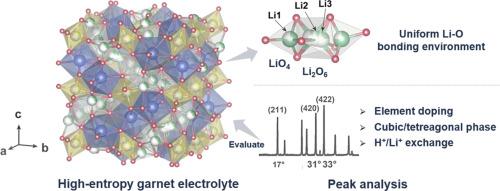评价石榴石电解质中高熵掺杂的可行性和空气稳定性
IF 20.2
1区 材料科学
Q1 CHEMISTRY, PHYSICAL
引用次数: 0
摘要
高熵电解质因其克服传统材料局限性的潜力而受到广泛关注。然而,确定准确合成单相高熵电解质仍然是一个挑战。本文研制了一种具有高耐空气腐蚀性能的立方相五石榴石电解质。通过分析衍射峰强度变化的简单方法,我们可以评价高熵掺杂的可行性、立方相的程度以及H+/Li+交换的程度。同时,利用环境压力x射线光电子能谱研究了H2O对石榴石电解质的降解,并通过核磁共振分析进一步阐明了其失效机理。在此基础上,与传统的高熵石榴石电解质相比,高熵石榴石电解质具有更高的立方相含量和更好的空气稳定性。因此,实现了更高的电流临界密度,促进了具有高面积容量的商用阴极集成到准固态电池中。我们的发现为高熵电解质的合成和评价提供了一种有效的方法。本文章由计算机程序翻译,如有差异,请以英文原文为准。


Evaluating the feasibility and air stability of high-entropy doping in garnet electrolytes
High-entropy electrolytes have attracted extensive attention for their potential to overcome the limits of traditional materials. However, confirming the accurate synthesis of a single-phase high-entropy electrolyte remains a challenge. Herein, we develop a quinary garnet electrolyte of cubic phase with high resistance to air corrosion. By employing a straightforward method that analyzes the variations of diffraction peak intensity, we can evaluate the feasibility of high-entropy doping, the degree of cubic phase, and the extent of H+/Li+ exchange. Meanwhile, ambient pressure X-ray photoelectron spectroscopy is utilized to investigate the degradation of garnet electrolyte by H2O, with the failure mechanism further elucidated by nuclear magnetic resonance analysis. On this basis, the high-entropy garnet electrolyte demonstrated increased cubic phase content and better air stability, compared with traditional counterpart. Consequently, a higher current critical density is achieved, facilitating the integration of commercial cathodes with high area capacities into the quasi-solid-state batteries. Our findings provide an effective method for synthesizing and evaluating high entropy electrolytes.
求助全文
通过发布文献求助,成功后即可免费获取论文全文。
去求助
来源期刊

Energy Storage Materials
Materials Science-General Materials Science
CiteScore
33.00
自引率
5.90%
发文量
652
审稿时长
27 days
期刊介绍:
Energy Storage Materials is a global interdisciplinary journal dedicated to sharing scientific and technological advancements in materials and devices for advanced energy storage and related energy conversion, such as in metal-O2 batteries. The journal features comprehensive research articles, including full papers and short communications, as well as authoritative feature articles and reviews by leading experts in the field.
Energy Storage Materials covers a wide range of topics, including the synthesis, fabrication, structure, properties, performance, and technological applications of energy storage materials. Additionally, the journal explores strategies, policies, and developments in the field of energy storage materials and devices for sustainable energy.
Published papers are selected based on their scientific and technological significance, their ability to provide valuable new knowledge, and their relevance to the international research community.
 求助内容:
求助内容: 应助结果提醒方式:
应助结果提醒方式:


